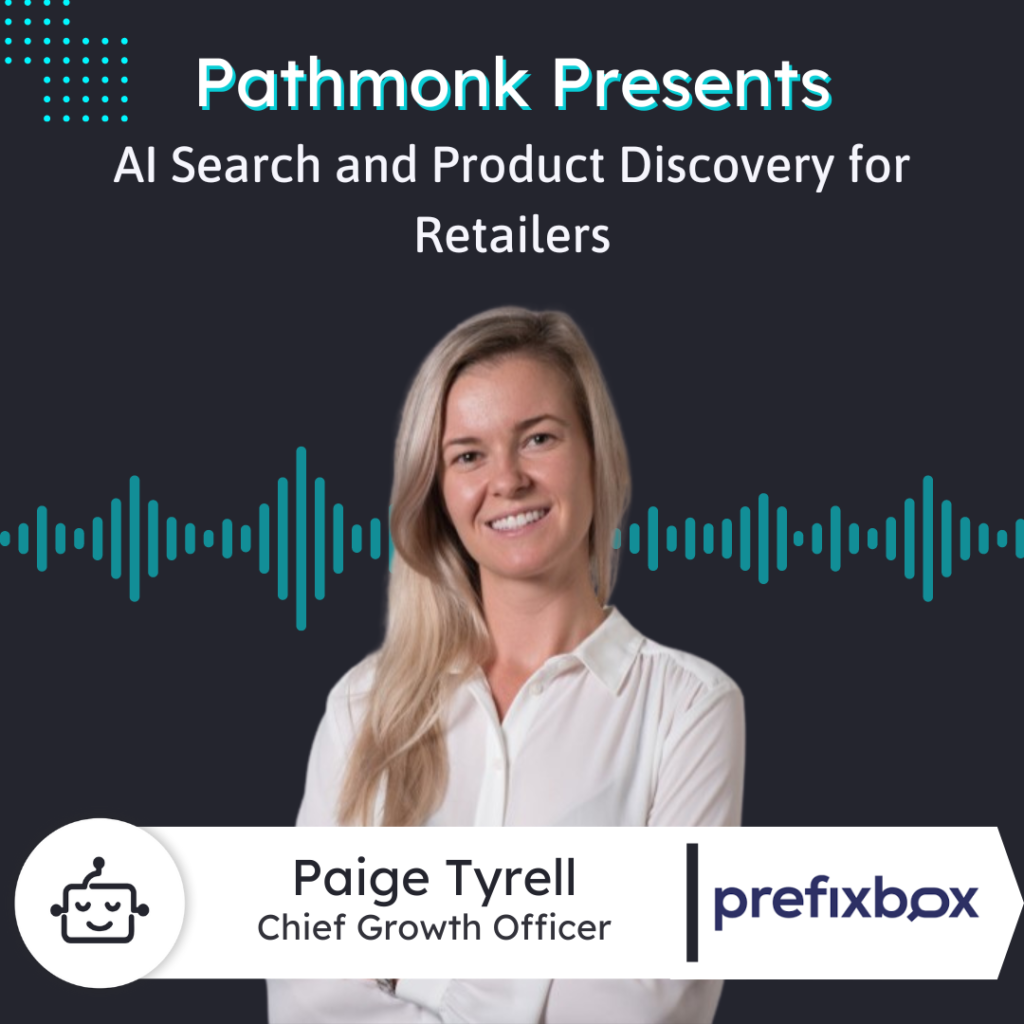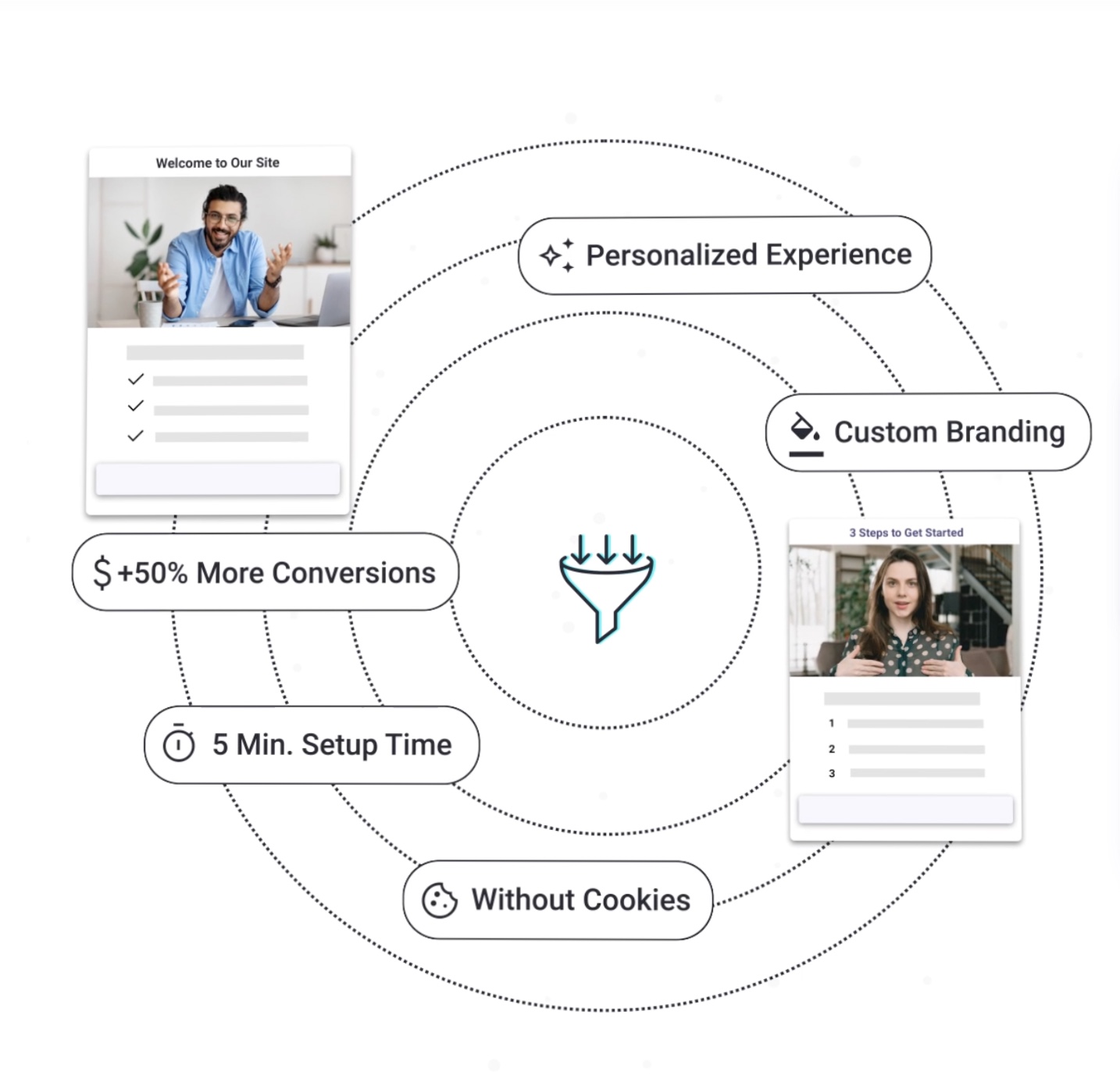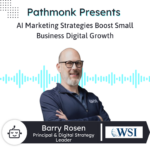
Introduction
This episode features Paige Tyrell, Chief Growth Officer at Prefixbox, a leading AI search and product discovery solution provider for e-commerce businesses.
Paige dives deep into how Prefixbox helps retailers increase conversion rates and online revenue by personalizing the product search experience for their customers. She explains how Prefixbox leverages AI to understand user behavior and deliver the most relevant product recommendations, ultimately enhancing the customer journey and driving sales.
Paige also sheds light on Prefixbox’s approach to marketing and sales in the ever-evolving tech landscape, emphasizing the importance of self-serve content and building trust through unbiased customer reviews.
More Sales From Your Website With AI
Personalized interactions based on your users' behaviour to get +50% more conversions.

Ernesto Quezada: Pathmonk is the intelligent tool for website lead generation, with increasing online competition over 98%. The ability to successfully show your value proposition as more visitors in their buying journey separates you from the competition online. Pathmonk qualifies and converts leads on your website by figuring out where they are in the buying journey and influencing key decision moments with relevant micro experiences like case studies, intro videos, and much more.
Stay relevant to your visitors and increase conversions by 50%. Add Pathmonk to your website in seconds. Let the AI do all the work and get up to 50 percent more qualified leads for you. Keep doing marketing and sales as usual. Check us out at pathmonk.com. Welcome to today’s episode. Let’s talk about today’s guest. We have Paige from Prefixbox, Chief Growth Officer with them. How are you doing today, Paige?
Paige Tyrell: I’m good. How are you? It’s nice to be here.
Ernesto: I’m good. Great to have you on. I’m doing good. Thank you so much for asking. I’m sure listeners are tuning in and wondering what Prefixbox is all about. So let’s kick it off with that, Paige. In your own words, can you tell us a little bit more?
Paige: Yes, sure. So Prefixbox is an AI search and product discovery solution for retailers. I know that not all of your listeners are in the e-commerce space. So what does that mean for other people? You know, whenever you go to buy something online and you see that white search bar at the top of the online store, and you focus in and maybe you type an N and it shows Nike shoes for men, Nike shirts for men. We do the technology that powers that. And then when you click enter, why is this product first? Why is this one second? Why is that third? We also power that. So it’s based on search relevance, obviously, and aggregated user behavior. And on the flip side, we enable retailers to promote the products that they want to sell. So for example, if they have a higher margin on product X and they want to show that first, then they can do that with our solution.
Ernesto: Oh, interesting. That’s really good. Even if they want to promote one, they can do so. But alternately, it’s hybrid search, right? What would you say?
Paige: Yeah, exactly. There were a lot of advancements in the search industry last year. That was the big buzz. And that basically paved the way for this AI search. That’s what we’ve brought to the market. We also have it in our product recommendations because retailers now are looking for a holistic solution that solves search and discovery. So product recommendations and for the end user, you would know this as like “other people also bought,” “complete your look,” “you might also like” those recommendations. When you’re looking at one specific product, we do that as well. And everything is, we have a detailed analytics portal so the retailers can see everything throughout the buying journey, what their shoppers are looking for, what they’re clicking on, what they’re interested in, and they can optimize based on this data that they find.
Ernesto: Right. Okay. Awesome. Great. So that way our listeners could get a good understanding. What would you say is a key problem that you solve?
Paige: We help retailers increase their conversion rate and online revenue. These are a couple of their top line KPIs, what they’re really looking to do. And since we offer this whole suite or range of products, all of these are geared to increasing the conversion rate and revenue. These people are really, really busy and search is complicated. Their teams can spend hours a week on doing these optimizations. Our products at Prefixbox are in a fully managed service. Our team of search experts handles all of that optimization for them. We do a lot of A/B testing, whether it’s what UX layout is working best, testing new features, new products, new search relevance settings. We do all of that and report on it to them so they can see everything in a concrete analytics portal. This shows the impact on your conversion rate, the impact on your revenue. And of course, all of that you can’t really quantify, like how is it impacting and improving the user journey?
Ernesto: Okay, awesome. So then, would it be fair to assume that you mainly focus on e-commerce clients? Or is there another vertical segment that you guys like to go for?
Paige: Yeah, we focus just on e-commerce search. We don’t do anything about content search. You’re exactly right. It doesn’t matter what products the retailers sell, whether it’s fashion or health and beauty or consumer electronics, DIY, whatever they sell is good to go. But we focus more on the enterprise, the mid-market and the enterprise, because our solution is data-driven and it learns from their user behavior. The more data that their customers generate and the shoppers generate on their site, the better our solution can work. So we don’t focus really on what they sell, but how big they are.
Ernesto: Okay. And how would someone in e-commerce typically find out about Prefixbox? Is there a top client acquisition channel for you guys?
Paige: Yeah, I think it’s changing now. In the past, most of what we did was a lot of sales focus, and it was outbound with emails, LinkedIn, calling, going to events, giving presentations, and positioning as a thought and market leader. Actually becoming part of the local community was important, building these personal relationships. But now what’s happening, at least in the tech sector, is that people want to do more of a self-led buying journey. They want to discover products on their own, learn about a solution provider on their own, what products are included, how much it costs, how it compares to others in the market, and they want to do that without necessarily talking to a salesperson. They want to see exactly how the product works. That’s a shift in the way you would approach this. We’re working towards that now where case studies are super important, letting the customer speak for themselves, whether it’s in a video interview or third-party reviews on a tech aggregator site. These unbiased opinions show how the technology works. I think that’s more powerful and resonates more because you can say anything about yourself, but when other people say it about you, it’s more powerful. We’re in the middle of a shift where these acquisition channels will change, but they should work together. We’re not going to completely leave the old world, but find a middle ground.
Ernesto: I agree. For our listeners that are listening in and want to check you guys out, they can visit prefixbox.com. What role would you say the website plays in the client decision-making?
Paige: The website is super important. It’s basically like your online brochure, online business card. Especially if you think about the self-guided role, the website is the go-to point in someone’s buying journey. That’s where they’ll go to learn about you, what you’re offering, and get all the information they want to collect. You need to have it all there in a clear and easy-to-understand way so they can digest it, understand what you’re saying, and go forward. In 2022, our big project was rebranding and working through the website and its flow. We knew it would be the focal point. Whether inbound or outbound is your channel, the website is always in the sales process. It’s unavoidable. We wanted to deeply document in an easy-to-understand way what exactly our solution can do and focus on our branding and messaging to make sure it resonates with our target audience. We looked at it holistically, and I think we did a good job. I was at a conference last May, and a UX and brand design specialist looked at our website and almost verbatim understood our persona, messaging, and brand personality. That was good validation. The website needs to educate your prospects and help them find what they’re looking for.
Ernesto: I really agree with you on that. Is there any tips or methods, tools that you would recommend to our listeners for website lead generation?
Paige: I think what I was touching on is to think about it all at once because it’s all interconnected. Your messaging, documentation, personas, how it relates to sales and marketing. Sit down and figure it out at one time so you have it clear in your mind what role this is playing and what it should be doing. If you start and then three months later do something else, and six months later do something else again, it’s not consistent. The thought process changes, especially if you just start adding pages and changing messages. It becomes unmanageable. So think about your CTAs, what the website should do, who you’re talking to, what you want them to do, how to guide them through it, where you want them to convert, and monitor it. Monitor the market, what your competitors are doing, how you’re positioned, if you’re communicating the right things, and monitor the website’s performance. Tools like Hotjar and Google Analytics show what people are doing on your website. Experiment on what’s working, what’s not, and adjust your page structure, content, and CTAs.
Ernesto: Awesome to hear that from you. Let’s switch gears a little bit. Let’s talk about you as a leader. You being the Chief Growth Officer for Prefixbox. What are some key tasks you focus on in your day-to-day work?
Paige: Every day is different. It’s very varied. I started as the first marketer and built the marketing department. Then I built the sales development representative department while also leading the marketing. Now I lead those two teams and am building out our partnership team. My day is spent between marketing, sales, and partnerships. It’s all related, making sure our messaging, offering, and packaging resonate with the market. Are we pushing the right messages on the right channels? Is it resonating with our ideal customers and personas? How can we iterate on it to drive more leads? The day-to-day is mostly planning, scoping, reviewing projects in progress, and thinking of things to experiment with to increase leads and grow the company.
Ernesto: Awesome to hear that from you. Let’s jump into our next section, Paige, which is a rapid-fire question round. Are you ready for that?
Paige: Yes. Let’s see.
Ernesto: All right. First off, Paige, what is the last book that you read?
Paige: “Lessons in Chemistry.” It was really good.
Ernesto: Great read there for our listeners. Next, what is one single thing that your company is focused on at the moment the most?
Paige: It’s about the packaging and positioning of the solution. We just launched this AI search last year. How can we weave that technology into everything we offer and structure the offering favorably to retailers? In this new economic climate, everyone’s focused on saving time and efficiency. How can we get the message that this latest technology is not just cool because it’s new and AI, but translated into real-world benefits that people can understand?
Ernesto: Awesome. Next, if there would be no boundaries in technology, what would be that one thing that you want to have fixed for your role as a marketer today?
Paige: I think it would be an analytics dashboard that has all data from all channels, including outbound and events, so you could see a full overview funnel of where leads are coming from, what happened, and how many touchpoints you had on each account, all in one place, aggregated. Whether it came from paid media, an SDR email, a conference, the website, organic search, and how many times you touched this account, without attribution problems. No more conversations about whether it was sales or marketing.
Ernesto: Definitely. I think that would be great. Hopefully, something like that exists. Next, if there was one repetitive task that you could automate, what would that be?
Paige: Paperwork because I’m an expat and I feel like every year I’m applying for visas. It’s not fun paperwork. If I didn’t have to think about any of that, I’d be really happy.
Ernesto: All right. Lastly, Paige, you have a lot of experience. What is one piece of advice that you would give yourself if you were coming out of university back in the day?
Paige: I would have said go move to Europe earlier. I came here late from the U.S. But yeah, get out of your comfort zone. If you think you can’t do something, you can. It’s just a mental limitation. Whatever you think, just go and do it and live your best life.
Ernesto: Awesome. Thank you so much, Paige. We’re coming to the end of the show here, but before we end, I want to give you the last word. If someone forgets everything about the interview today, what is that one thing they should remember about Prefixbox?
Paige: AI product search and discovery increases conversion rate and online revenue for retailers.
Ernesto: There you guys heard it. Check them out at prefixbox.com. To our listeners, thank you so much for tuning in, and I’m looking forward to our next episode at Pathmonk Presents. Thanks a lot, Paige.
Paige: Thank you.










